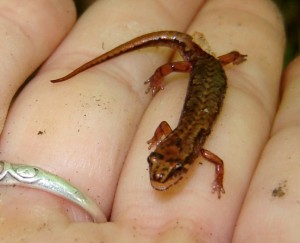
TUSCALOOSA, Ala. — Like many amphibians, salamanders are declining at an alarming rate around the planet, but scientists have discovered a new kind of salamander scurrying about in central sections of the Blue Ridge Mountains.
The newly minted Northern Pigmy Salamander, whose scientific name is Desmognathus organi, was officially declared a new species by the Center for North American Herpetology on Aug. 26.
“Identifying new species is significant for several reasons,” says Dr. Leslie Rissler, associate professor of biological sciences at The University of Alabama, who wrote, along with Drs. Erica J. Crespi, of Vassar College, and Robert A. Browne, of Wake Forest University, the official description of the new species.
“It is important because species are the pinnacle of the evolutionary process, providing important clues to scientists interested in understanding earth history,” Rissler said. “It is also important because we are in a biodiversity crisis. Understanding the patterns of biodiversity is a crucial first step to ensuring the continued presence of other species on our planet.”
Describing the species followed several years of research on the slick-skinned critter native to the highest spruce-fir mountains in the southeastern U.S.
The newly discovered species is, as an adult, about one to two-inches long, the color of darkened copper with a wavy, zippered pattern on the back. The adults exhibit parental care – taking care of their eggs until they hatch into miniature adults.
The bigger picture, however, is about more than salamanders, Rissler says.
“Amphibians are important indicators of the health of the environment. They are sensitive to environmental change and emerging diseases because they live in both aquatic and terrestrial environments and breathe through their skin. Thus, they are a type of ecological sentinel.
“Amphibians are the most threatened group of vertebrate on the planet,” Rissler said. “The southeastern U.S. is the world hotspot for salamander biodiversity, and we are lucky to share our homes with some of the most amazing creatures on our planet. As Alabamians, we should be proud of the natural heritage of our state and surrounding regions and aim to preserve it. But, first we need to document and understand biodiversity.”
The new species’ range extends north of the French Broad River valley in North Carolina northward to Whitetop Mountain and Mount Rogers, Va., but only on the highest peaks. Previously, scientists had considered this species to be the same kind of animal designated as Desomognathus wrighti, which is distributed south of the French Broad almost to the Georgia line.
The researchers named the new species after Dr. James Organ, a scientist who first studied the populations of species living in southwestern Virginia in 1961. Rissler recently met Organ, telling him he would soon have a new species named after him.
“It was a rare experience and a real joy to be able to tell a biologist that his name would forever be associated with a new species – one that he had studied for a half century. I think he was quite pleased.”
Rissler and her colleagues have shown, through DNA sequencing, morphological analyses and ecological modeling that the two species not only differ genetically but also in several measures of body size, including overall length, snout length and head width, and also in color and habitat choice.
Both climate change and habitat destruction are impacting the new species, Rissler says.
“Now that we have formally designated Desmognathus organi as a separate species, scientists and federal agencies can assess its status to determine if formal protective measures should be taken to ensure its survival.”
The original salamanders for which the new species was named are permanently stored in The University of Alabama Herpetological Collection where Rissler is curator. She teaches in UA’s department of biological sciences.
UA’s department of biological sciences is part of UA’s College of Arts and Sciences, the University’s largest division and the largest liberal arts college in the state. Students from the College have won numerous national awards including Rhodes Scholarships, Goldwater Scholarships and memberships on the USA Today Academic All American Team.
Contact
Chris Bryant, UA Media Relations, 205/348-8323, cbryant@ur.ua.edu
Source
Dr. Leslie Rissler, 205/348-4052, rissler@bama.ua.edu